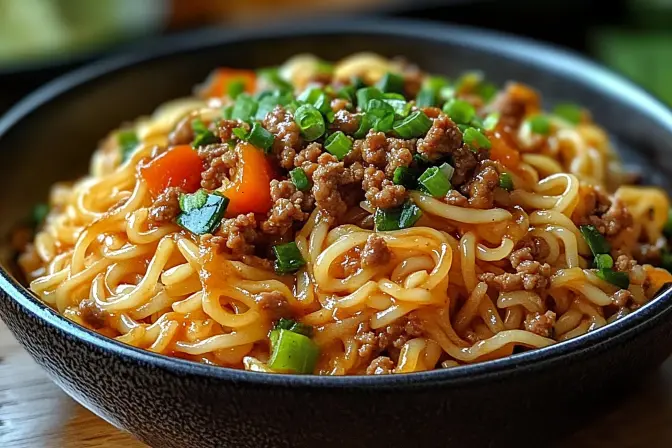Description
This Mongolian Ground Beef Noodles recipe delivers a satisfying and flavorful meal in under 30 minutes. It’s a weeknight wonder, featuring tender ground beef simmered in a rich, savory-sweet sauce, all tossed with perfectly cooked linguine. The combination of soy sauce, hoisin, brown sugar, and ginger creates an irresistible Asian-inspired flavor profile that will tantalize your taste buds. Garnished with fresh green onions, this dish offers a delightful contrast of textures and vibrant flavors. It’s comfort food with a global twist, easily customizable to your spice preference.
Why you will love this recipe
You’ll fall in love with this recipe for several reasons:
- Quick and Easy: Perfect for busy weeknights, this recipe comes together in under 30 minutes, making it an ideal solution when you’re short on time but craving a delicious and homemade meal.
- Flavor Explosion: The savory-sweet sauce, infused with the aromatic blend of garlic, ginger, and hoisin sauce, creates a complex and addictive flavor that will leave you wanting more. The little bit of red pepper flakes add an extra layer of heat, making the dish extra flavorful.
- Budget-Friendly: Ground beef is an affordable protein, making this a cost-effective option for feeding the whole family. You can often find it on sale, and with pantry staples like soy sauce and brown sugar, you likely already have many of the ingredients on hand.
- Customizable: Easily adapt the recipe to your liking. Adjust the amount of red pepper flakes for your desired spice level, swap out linguine for your favorite pasta shape, or add vegetables like broccoli or bell peppers for extra nutrition.
- Family-Friendly: The slightly sweet and savory flavor profile appeals to both adults and children, making it a dish that everyone at the table will enjoy. Even picky eaters are likely to find something to love about this noodle dish.
- One-Pan Wonder: Most of the cooking happens in one skillet or large pan, which means fewer dishes to wash – a definite win in any busy household.
Ingredients:
- 1 lb ground beef
- 5 cloves garlic, minced
- 1/3 cup brown sugar
- 1/4 cup beef broth
- 1/3 cup soy sauce
- 3 tablespoons hoisin sauce
- 1/2 teaspoon ground ginger
- 1/2 teaspoon ground black pepper
- Pinch of red pepper flakes (optional, for a spicy kick)
- 10 oz linguine
- 1 tablespoon cornstarch
- 2 tablespoons water
- 4 green onions, sliced for garnish
Preparation:
Step 1: Cook the Pasta
Bring a large pot of salted water to a rolling boil. Add the linguine and cook according to package directions until al dente. This usually takes around 8-10 minutes. Al dente pasta holds its shape better when tossed with the sauce, preventing it from becoming mushy. Once cooked, drain the pasta in a colander. Don’t rinse it unless you plan to use it much later. Rinsing removes the starch, which helps the sauce adhere to the noodles.
Step 2: Brown the Ground Beef
In a large skillet or wok, heat over medium-high heat. Add the ground beef and cook, breaking it up with a spoon, until it is fully browned and no longer pink. This usually takes about 5-7 minutes. Ground beef with a higher fat content will render more grease, so consider using a leaner ground beef if you want to reduce the amount of fat in the final dish. Once the beef is browned, carefully drain any excess fat from the skillet, leaving only a tablespoon or two for flavor. Removing the excess fat prevents the dish from becoming greasy and heavy.
Step 3: Add Aromatics and Sauces
Add the minced garlic to the skillet with the browned beef. Cook for about 1 minute, or until the garlic becomes fragrant. Be careful not to burn the garlic, as it can become bitter. Stir continuously to prevent sticking. Next, pour in the soy sauce, beef broth, brown sugar, hoisin sauce, ground ginger, black pepper, and red pepper flakes (if using). Stir well to combine all the ingredients and ensure the brown sugar dissolves. This mixture forms the base of the delicious, savory-sweet sauce. The combination of these ingredients is what gives the dish its signature Mongolian flavor profile.
Step 4: Thicken the Sauce
In a small bowl, whisk together the cornstarch and cold water until smooth, creating a slurry. This slurry acts as a thickening agent for the sauce. Make sure there are no lumps in the cornstarch mixture, as this will result in a lumpy sauce. Pour the cornstarch slurry into the skillet with the beef and sauce. Stir continuously and allow the sauce to simmer for about 2-3 minutes, or until it thickens to your desired consistency. The sauce should be thick enough to coat the noodles without being too gloppy. Adjust the amount of cornstarch slightly if needed to achieve the perfect consistency.
Step 5: Combine with Noodles and Serve
Add the cooked and drained linguine to the skillet with the beef and sauce. Toss everything together thoroughly until the noodles are evenly coated with the flavorful sauce. Make sure every strand of pasta is glistening with the sauce for maximum flavor in every bite. Let the noodles simmer in the sauce for a few minutes to allow them to absorb the flavors further. Sprinkle the sliced green onions over the noodles for garnish. The green onions add a fresh, vibrant flavor and a pop of color to the dish. Serve hot immediately and enjoy!
COOKING Rating:
Easy
Serving Suggestions:
- Serve as a main course for lunch or dinner.
- Pair with a simple side salad or steamed vegetables like broccoli or bok choy for a complete meal.
- Offer a sprinkle of sesame seeds or a drizzle of sesame oil for added flavor and visual appeal.
- Add a side of steamed rice to soak up any extra sauce.
- Serve with your favorite Asian-inspired appetizers, such as spring rolls or potstickers.
- Serve with a spicy chili oil on the side for those who prefer extra heat.
Tips:
- For a vegetarian option, substitute the ground beef with crumbled tofu or plant-based ground meat.
- Add your favorite vegetables, such as sliced bell peppers, mushrooms, or snap peas, to the skillet along with the garlic for added nutrition and flavor.
- Adjust the amount of brown sugar to your liking, depending on how sweet you want the sauce to be.
- Use low-sodium soy sauce to control the sodium content of the dish.
- Store leftovers in an airtight container in the refrigerator for up to 3 days. Reheat in the microwave or on the stovetop until heated through.
- If the sauce becomes too thick upon reheating, add a splash of beef broth or water to thin it out.
- Add a squeeze of lime juice for a tangy twist.
- Try adding a tablespoon of peanut butter to the sauce for a richer, nuttier flavor.
- For a richer flavor, try using beef broth made from bouillon cubes or powder.
- If you’re in a hurry, you can use pre-cooked noodles or rice noodles to save time.
Prep Time:
10 minutes
Cook Time:
20 minutes
Total Time:
30 minutes
Nutritional Information:
- Calories: Approximately 650 kcal per serving (estimated)
- Protein: Approximately 35g per serving (estimated)
- Sodium: Approximately 1200mg per serving (estimated)
Conclusion
Mongolian Ground Beef Noodles is a delicious and versatile dish that is sure to become a family favorite. Its combination of savory-sweet flavors, quick preparation time, and customizable ingredients makes it a winner for any occasion. So, gather your ingredients, fire up your skillet, and get ready to enjoy a satisfying and flavorful meal that’s ready in just 30 minutes! This recipe offers a comforting and flavorful experience, perfect for busy weeknights or a relaxed weekend meal. Don’t hesitate to experiment with different additions and substitutions to create your own unique version of this classic dish.
Questions and Answers about Mongolian Ground Beef Noodles:
Q1: Can I use a different type of pasta other than linguine?
A: Absolutely! While linguine is a classic choice that works well with the sauce, feel free to substitute it with other pasta shapes like spaghetti, fettuccine, or even egg noodles. The key is to choose a pasta that can hold the sauce well. Thicker pastas like fettuccine will have a slightly chewier texture, while thinner pastas like spaghetti will be more delicate. Egg noodles offer a richer flavor and a soft texture that pairs nicely with the savory-sweet sauce. You can even use gluten-free pasta options for a gluten-free version of this dish. The choice is yours, so experiment and find your favorite combination!
Q2: How can I make this recipe spicier?
A: If you’re a fan of spicy food, there are several ways to kick up the heat in this Mongolian Ground Beef Noodles recipe. The easiest option is to add more red pepper flakes to the sauce. Start with a generous pinch and adjust to your taste. You can also add a teaspoon or two of sriracha sauce or chili garlic sauce to the sauce for extra flavor and heat. Another option is to use a spicier ground beef, like one seasoned with chili powder or cayenne pepper. For a more subtle heat, you can add a few thinly sliced fresh chili peppers, such as jalapeños or serranos, to the skillet along with the garlic.
Q3: Can I make this recipe ahead of time?
A: Yes, you can definitely make this recipe ahead of time, which makes it a great option for meal prepping or entertaining. The flavors actually meld together even better as the dish sits. Prepare the ground beef and sauce as instructed, but don’t add the noodles yet. Store the sauce separately in an airtight container in the refrigerator for up to 3 days. When you’re ready to serve, cook the pasta and toss it with the reheated sauce. You may need to add a splash of beef broth or water to the sauce to thin it out slightly, as it may thicken upon reheating. This way, you can enjoy a fresh and flavorful meal without spending a lot of time in the kitchen on the day of serving.
Q4: What are some good vegetable additions to this dish?
A: There are plenty of vegetables that complement the flavors of this Mongolian Ground Beef Noodles dish. Some popular choices include broccoli florets, sliced bell peppers (any color), sliced mushrooms, snap peas, shredded carrots, and spinach. Add the vegetables to the skillet along with the garlic and cook until they are tender-crisp. This usually takes about 5-7 minutes. You can also add frozen vegetables directly to the skillet; just make sure to thaw them slightly beforehand. Vegetables not only add nutritional value to the dish but also provide a welcome contrast in texture and flavor.
Q5: Can I use a different type of sweetener instead of brown sugar?
A: Yes, you can certainly use a different type of sweetener in place of brown sugar. Honey is a great alternative that adds a similar sweetness and a slightly floral flavor. Maple syrup is another good option, providing a rich and caramel-like flavor. You can also use granulated sugar or coconut sugar, but you may need to adjust the amount to achieve the desired sweetness. Start with a smaller amount and add more to taste. Keep in mind that different sweeteners will have slightly different flavors, so the overall taste of the dish may vary slightly.




